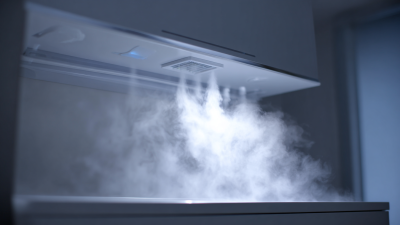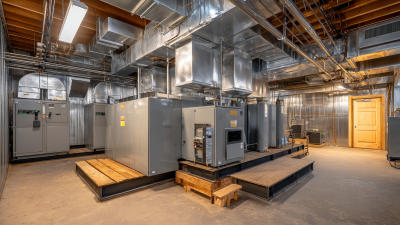As homeowners become increasingly aware of the impacts of indoor air quality on health and well-being, the importance of maintaining optimal humidity levels has gained significant attention. According to the Environmental Protection Agency (EPA), inadequate humidity control can lead to a host of problems, including respiratory issues, increased susceptibility to infections, and discomfort caused by dry skin and irritation. This makes devices like the steam humidifier for furnace an essential component of creating a comfortable living environment, especially during harsh winter months when indoor air tends to dry out substantially.

Research indicates that maintaining indoor relative humidity levels between 30% and 50% can not only enhance comfort but also contribute to energy efficiency. A study published by the American Society of Heating, Refrigerating and Air-Conditioning Engineers (ASHRAE) revealed that properly humidified air can improve perceived temperature and reduce heating costs, as humid air feels warmer than dry air. This synergy between comfort and energy saving emphasizes the role of steam humidifiers for furnaces, which not only address humidity challenges but also optimize heating system performance.
Furthermore, the prevalence of asthma and allergies has risen, affecting millions worldwide. The Asthma and Allergy Foundation of America reports that poor indoor air quality exacerbates these conditions. Implementing steam humidifiers in HVAC systems can help alleviate these issues by maintaining adequate moisture levels, thereby promoting a healthier indoor atmosphere. Understanding the science behind these devices and their manifold benefits is crucial for homeowners seeking to enhance their living conditions while prioritizing health and efficiency.
Steam humidifiers are an effective solution for enhancing home comfort by working in conjunction with furnaces. These devices operate by heating water to produce steam, which is then distributed throughout the home through the existing ductwork of the heating system. Unlike traditional humidifiers that rely on evaporation, steam humidifiers provide a consistent and controlled level of humidity, resulting in a more comfortable indoor environment, especially during dry winter months.
The mechanism of steam humidifiers relies on a heating element that boils water, creating steam that is injected into the airflow of the furnace. This steam increases the moisture content in the air, combating the adverse effects of dry air, such as skin irritation, respiratory issues, and damage to wooden furniture. Furthermore, with adjustable settings, users can tailor humidity levels to their preference, ensuring optimal comfort while also protecting their home and health. By integrating steam humidifiers with furnaces, homeowners can achieve a balanced humidity level, enhancing overall comfort and indoor air quality.
Steam humidifiers for furnaces are becoming increasingly recognized for their significant impact on indoor air quality. According to the Environmental Protection Agency (EPA), maintaining optimal humidity levels between 30% and 50% can enhance comfort and reduce the proliferation of airborne pathogens. By utilizing steam humidifiers, households can achieve and sustain this ideal range, mitigating the dryness often caused by conventional heating systems, especially during the colder months.
In addition to improving comfort, steam humidifiers also play a crucial role in preserving the structural integrity of homes. The Building Research Council reports that low humidity can lead to issues such as cracking walls and furniture damage, which often require expensive repairs. Moreover, optimal humidity levels can alleviate common health issues, such as dry skin, irritated sinuses, and respiratory problems. Numerous studies indicate that homes equipped with steam humidifiers allow for better air quality, contributing to overall wellness and productivity for residents. As awareness grows regarding the importance of humidity control, steam humidifiers are emerging as a vital component in the pursuit of a healthier indoor environment.
When evaluating humidification methods, steam humidifiers stand out for their effectiveness in providing consistent moisture levels. According to the American Society of Heating, Refrigerating and Air-Conditioning Engineers (ASHRAE), maintaining indoor relative humidity between 30% and 50% is optimal for both comfort and health. Steam humidifiers use the process of boiling water to produce steam, which is then cooled, resulting in warm, moist air being distributed throughout the home. This approach is particularly beneficial in colder months, as it not only increases humidity but also raises the temperature slightly, enhancing overall comfort.
In contrast, other humidification methods, such as evaporative or ultrasonic humidifiers, have their advantages but also limitations. Evaporative humidifiers rely on a fan blowing air through a wet wick, which may struggle to maintain high humidity levels in large spaces or extremely dry conditions. Furthermore, they can be prone to mineral buildup, requiring regular maintenance. On the other hand, ultrasonic units are quieter and more energy-efficient but often fail to provide the same level of humidity consistency, especially in larger homes. A study by the Indoor Air Quality Association (IAQA) highlighted that homes using steam humidifiers reported a 20% reduction in dry skin and respiratory discomfort compared to those using alternative methods, showcasing the clear benefits of steam in enhancing home comfort.
Proper installation and maintenance of steam humidifiers are essential for achieving optimal performance and ensuring a comfortable home environment. Begin the installation process by selecting a suitable location that allows for proper airflow and easy access to the furnace. It's crucial to follow the manufacturer's guidelines closely, ensuring that all connections are secure and that the unit is leveled correctly. When integrating the steam humidifier with the existing heating system, ensure that the water supply is readily available, and check for any leakage during setup. A professional installer can be beneficial if you're unfamiliar with furnace systems.
Once installed, regular maintenance is key to the longevity and efficiency of your steam humidifier. Schedule routine checks to clean the unit and replace any worn components, such as the steam canister or filter. It's advisable to inspect the water supply for mineral build-up, which can hinder performance. Additionally, monitoring humidity levels with a hygrometer can help in adjusting settings for optimal comfort. By committing to these installation and maintenance practices, homeowners can maximize the benefits of steam humidifiers, ultimately enhancing the indoor climate throughout the heating season.
This bar chart illustrates the average indoor humidity levels across different seasons when using steam humidifiers. The data indicates that humidity is typically lower in winter months and higher during spring and summer, contributing to overall home comfort.
Humidity plays a crucial role in enhancing energy efficiency in home heating systems. When the air is properly humidified, it feels warmer at lower temperatures, allowing homeowners to set their thermostats a few degrees lower without sacrificing comfort. This means that with the right humidity levels, a furnace can operate more efficiently, ultimately reducing energy consumption and lowering heating bills. The ideal indoor humidity level typically ranges between 30% to 50%, which can help maximize comfort while minimizing energy used for heating.
Moreover, steam humidifiers integrated with furnaces can help maintain consistent humidity levels throughout the home. These devices add moisture to the air generated by the furnace, preventing it from becoming too dry during colder months. Not only does this enhance comfort by alleviating dry skin and respiratory issues, but it also prevents damage to wooden furniture and flooring caused by excessively low humidity. By investing in steam humidifiers, homeowners can create a more energy-efficient environment that promotes both comfort and well-being during the heating season.





